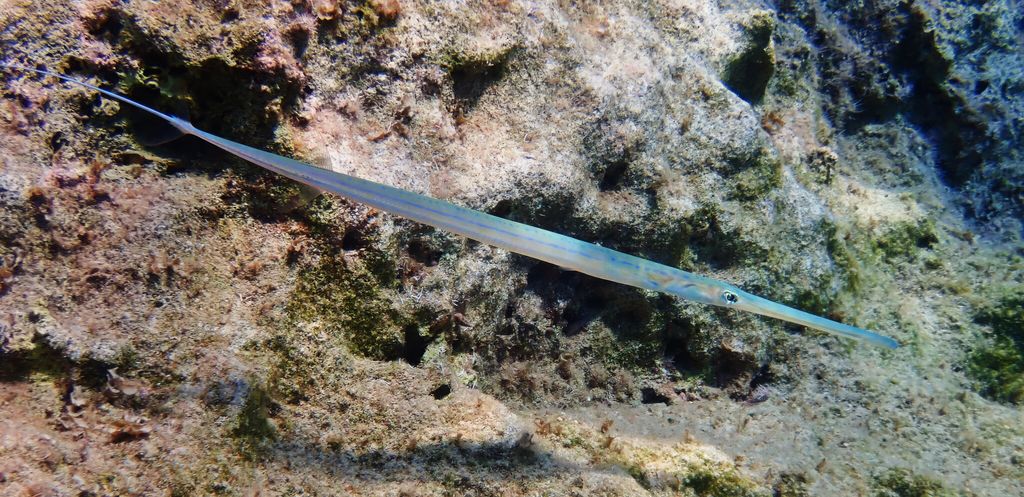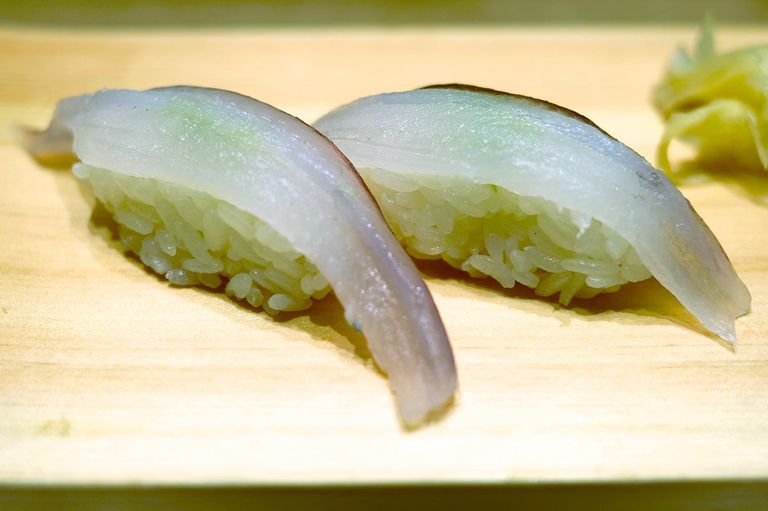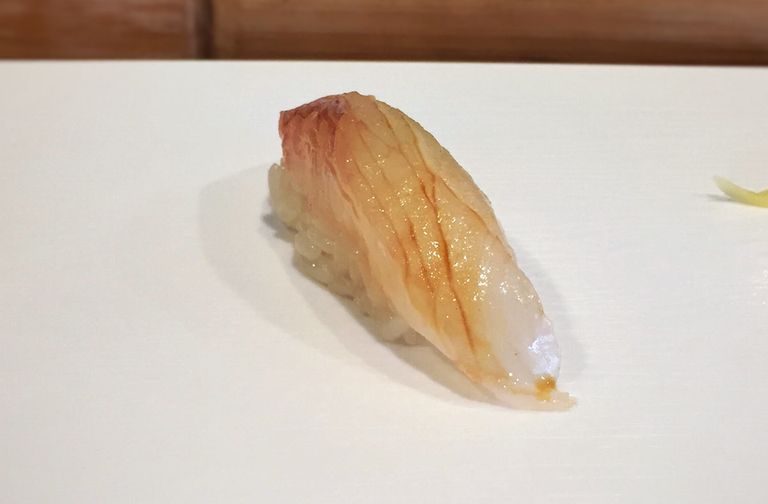Yagara Sushi
A Comprehensive Overview of Cornetfish in Japanese Sushi Cuisine
ヤガラすし 、 簳魚寿司 
What is Yagara?
The cornetfish or flutefish are known as yagara 簳魚 in Japan. These fish belong to the order of pipefishes and are characterized by their strikingly slender, elongated shape. There are four species of cornetfish worldwide. The species found in Japan, the bluespotted cornetfish (Fistularia petimba) and the red cornetfish (F. commersonii), are both simply referred to as yagara in everyday life and outside professional contexts. The red cornetfish is preferred to the bluespotted cornetfish and is therefore more expensive.[1] They are of very little economic importance and are mainly caught as by-catch. Yagara not only impress with their unusual appearance, albeit quite a rare ingredient for sushi or sashimi, although they are a rather rare choice in this respect.
Yagara for Sushi or Sashimi
Yagara has tender white meat that is perfect for making sushi or sashimi. It is also appreciated for grilled, steamed or as an addition to clear soups. The meat is firm but tender. The taste is mild and light, the meat is firmer than that of many other white-fleshed fish.
Yagara in Japan
Cornetfish have different names in different regions of Japan. In the Osaka and San'in region, they are called taihō たいほう, a term that translates as “cannon”. This name could allude to the fish's elongated shape or its ability to move quickly through the water, similar to the speed of a cannon shot. In the northern areas of Kyushu and in Kagoshima, the name fue sakana 笛魚can be found, which can be directly translated as “flute fish”. This name refers to the slender, elongated shape of the fish, which is reminiscent of a flute. In Okinawa, the cornetfish is called hīfuchā ヒーフチャー, which can be interpreted as “fire-breathing bamboo”. This term originally served as a metaphor for a soldering tube, a tool used in metalworking to melt and join metals. The metaphorical use of this term for the cornetfish, like the term flute, is a reference to its special appearance.
Characteristics & Ecology of Yagara

Gejuni. Glatter Flötenfisch (Fistularia commersonii). wikimedia.org. Some rights reserved: CC BY-SA 3.0 DE DEED. Changes applied: contrast, crop, hue, saturation
Yagara is a noticeably slim and elongated predatory fish. Its skin is from reddish to orange-brown coloration, which shows a pattern of broad cross bands at night. Young fish are spotted, with increasing age these disappear. Cornetfish fish are twilight-active, secret robbers, who stalk their prey. Thanks to their slender shape, they can remain undetected long enough to then scurry forward to suck their prey into their mouth.
Red Cornetfish
The red or rough cornetfish (Fistularia petimba), known as aka yagara in Japan, is common in the warmer regions of the Atlantic and Indo-Pacific, especially around Australia and Japan. Occasional sightings have been documented in the Mediterranean up to the Aegean. Observations of catches off the coast of Andalusia indicate that the species has migrated into the Mediterranean via the Strait of Gibraltar.[2] The species mainly lives in subtropical zones, but in the tropics it can be found at greater depths or in areas with cold currents. The red cornetfish is crepuscular and forages methodically, adapting to its environment to approach schools of small fish unnoticed. When it approaches its prey, it advances quickly and seizes it by sucking. It usually lives alone or in small groups and feeds on small fish and crustaceans. It is easy to mistake it for the blue-spotted cornetfish, which is distinguished by its greenish-brown coloration and lacks bony plates along the midline of the back.
Bluespotted Cornetfish

Sarah Faulwetter. 222165262. inaturalist.org. Some rights reserved: CC BY 4.0 DEED. Changes applied: brightness, contrast, saturation, white balance
The distribution range of the bluespotted or smooth cornetfish (Fistularia commersonii), named ao yagara in Japanese, extends from the tropical and subtropical regions of the Indo-Pacific to northern Japan and the western coasts of America, including Panama and the Gulf of California and the Red Sea.[3] In 2000, it was confirmed to occur in the Mediterranean Sea near Israel, also known as the Levantine Sea.[4] Since then, the population there has increased significantly, accompanied by a spread into the western Mediterranean up to the bay of the French Mediterranean coast and the southern Spanish coasts.[5] Classified as an invasive species in the Mediterranean due to its rapid spread and negative impact on native fish populations.[6] Research suggests that the Mediterranean population of this fish is descended from a limited number of ancestors, likely from a single invasion event, resulting in lower genetic diversity compared to populations in the Red Sea.[7]
Season Calendar for Yagara
The calendar shown does not provide information on fishing times, but marks the periods in which yagara is considered particularly tasty.
Video about Yagara Sushi
External video embedded from: youTube.com. Credit 99チャンネル 99chtv. 親方、ヤガラと背比べ 平戸・エビス亭 Masterchef, comparing height with a cornetfish with English subtitles.
Species of Yagara
The following species are regarded as authentic yagara. Either historically, according to the area of distribution or according to the common practice in today's gastronomy:
Sources and Further Reading
- [1]藤原昌高. 『アカヤガラ | 魚類 | 市場魚貝類図鑑』. Bozu Konnyaku Co., Ltd., Tokyo ぼうずコンニャク株式会社東京、 2023. Source retrieved 4/23/2024
- [2]Dragicevic, B., Anadoli, O., Angel, D., Benabdi, M., Bitar, G., Castriota, L., ... & Zenetos, A.. New Mediterranean Biodiversity Records (December 2019). Mediterranean Marine Science 20 (3) 645-656. 2019. DOI: 10.12681/mms.20913.
- [3]Froese, R. and D. Pauly. Editors. Fistularia commersonii - Rüppell, 1838. Bluespotted cornetfish. 2023. Source retrieved 1/24/2024
- [4]D. Golani. First record of the bluespotted cornetfish from the Mediterranean Sea. Fish Biology 56 (6) 1545-1547. 2005. DOI: 10.1111/j.1095-8649.2000.tb02163.x.
- [5]Domenico Meloni, Pierluigi Piras. null. Biodiversity Journal 4 (3) 435-438. 2013
- [6]Evelyn Ragheb. Morphometric and meristic characteristics of the first record Fistularia petimba (Lacepède, 1803) and Fistularia commersonii (Rüppell, 1838) (Piscès: Fistulariidae) from the Egyptian Mediterranean waters (West Alexandria). The Egyptian Journal of Aquatic Research 48 (2) 143-150. 2022. DOI: 10.1016/j.ejar.2022.01.003.
- [7]Azzurro, E., Soto, S., Garofalo, G.. Fistularia commersonii in the Mediterranean Sea: invasion history and distribution modeling based on presence-only records. Biol Invasions 15 977–990. 2013. DOI: 10.1007/s10530-012-0344-4.
- 昌髙藤原. 『ぼうずコンニャクの市場魚貝類図鑑 (Bozu Konyaku's Market Fish and Shellfish Book)』. Bozu Konnyaku Co., Ltd., Tokyo ぼうずコンニャク株式会社東京, zukan-bouz.com、 2020. Source retrieved 12/27/2021
- IUCN Red List of Threatened Species. Version 2023-1
Image Credits
- SushiPedia. Yagara. All rights reserved ©
- Jun Seita. Yagara, Fujifilm X-T1. flickr.com. Some rights reserved: Attribution 2.0 Generic (CC BY 2.0)
- T.Tseng. Yagara (trumpet fish), Shunji Japanese Cuisine, West L.A.. flickr.com. Some rights reserved: Attribution 2.0 Generic (CC BY 2.0)
- Sarah Faulwetter. 222165262. inaturalist.org. Some rights reserved: CC BY 4.0 DEED. Changes applied: brightness, contrast, saturation, white balance
- Gejuni. Glatter Flötenfisch (Fistularia commersonii). wikimedia.org. Some rights reserved: CC BY-SA 3.0 DE DEED. Changes applied: contrast, crop, hue, saturation

